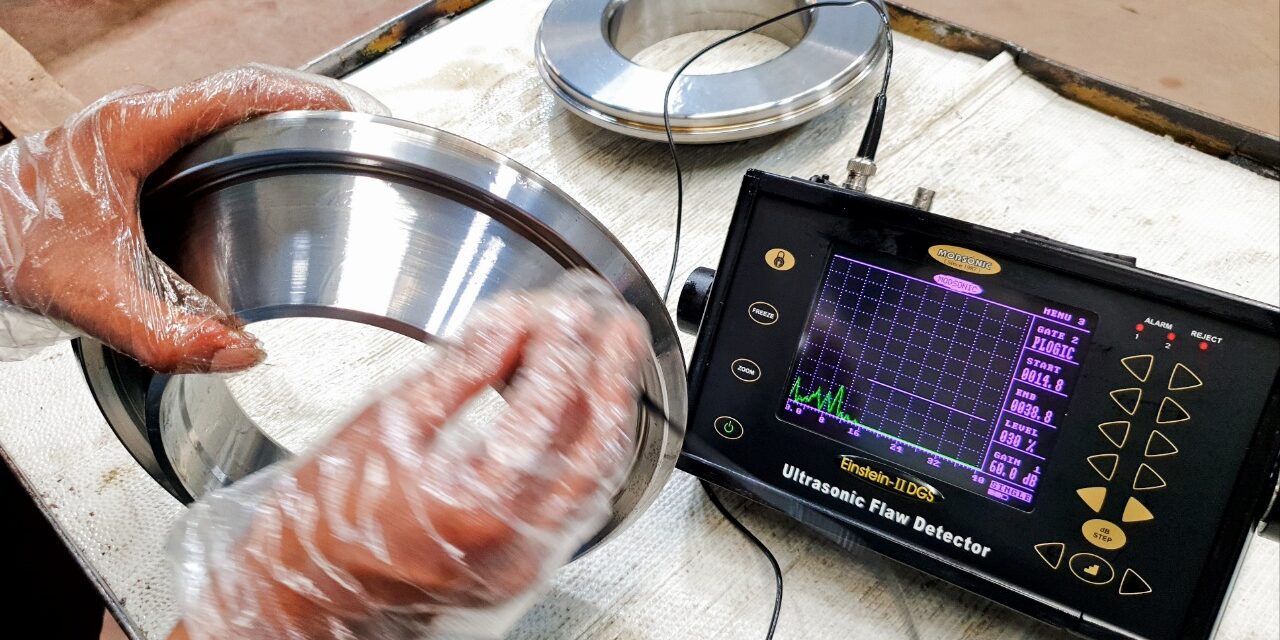Ultrasonic flaw detection equipment uses NDT (non-destructive testing) methods to detect surface and subsurface flaws. As the name suggests it uses high-frequency ultrasonic waves for this purpose. A transducer emits the waves into the test object. The returning waves generate clear echo patterns which are then recorded, displayed in the form of images, and interpreted.
Ultrasonic flaw detectors are used across industries for quality inspections. Some of the industries that use ultrasonic flaw detection extensively are infrastructure, manufacturing, automotive, aerospace, oil exploration & pipelines, and transportation including railroads.
The flaw detectors are used to check the integrity of welds and for evaluating structures like bridges, boiler tubes, aerospace & wind turbine composites, railroad axles & rails, and in several other industrial applications. Ultrasonic flaw detectors are established as non-hazardous, non-destructive, and reliable quality assurance tools in the industry today.
Origins of Ultrasonic Flaw Detection Equipment
Ultrasonic flaw detectors utilize ultrasonic testing for the purpose. Soviet Scientist Sergei Y. Sokolov conducted experiments in ultrasonic testing and demonstrated in 1928 how ultrasonics could be used to detect flaws in metals. Sokolov proposed the industrial use of ultrasonics for testing flaws in solid materials. His experiments laid the foundation of modern ultrasonic testing and flaw detection techniques that are used today.
German scientist Raimar Pohlman used the idea and built upon it further. He designed the Pohlman cell for the detection of flaws using ultrasonic beams. A similar device was built in 1939 by scientists at the British Iron and Steel Institute which could test minute hairline fractures in steel by employing ultrasonic waves. Since World War 2 was imminent at the time, therefore for fear of espionage, its industrial use was prohibited for the time.
Initial Commercial Application of Ultrasonic Flaw Detection Equipment
Development and industrial use of ultrasonic flaw detectors gained major traction in the forties. In 1942, British scientist Donald Sproule created an apparatus to detect flaws in steel. Based on the principle of echo-sounding this apparatus had separate transducers for transmission and reception.
Around the same time, American physicist Floyd Firestone and Adolf Trost of Germany developed similar ultrasonic devices. Both of them found industrial partners and began commercial production of their equipment. While Trost’s product was named ‘Trost-Tonge’, Firestone’s product was called by various names such as Firestone-Sperry Reflectoscope, the Sperry Ultrasonic Reflectoscope, and ‘Supersonic Reflectoscope’ as originally intended by Firestone.
Japanese corporations too began to develop ultrasonic flaw detectors and by 1949, Mitsubishi Electric Corporation, the Japan Radio Company, the Shimadzu Manufacturing Company, and the Tokyo Ultrasonic Industrial Company began the commercial production of ultrasonic devices.
Evolution of Ultrasonic Flaw Detection Equipment
Ultrasonic flaw detectors have evolved greatly since their inception. From early instruments that employed bulky vacuum tubes that consumed enormous amounts of energy gave way to smaller and portable battery-operated devices that used solid-state circuitry.
In 1984, panametrics, a major non-destructive testing company introduced a digital flaw detector device that heralded the shift from analog signal processing applied till then to digital processing. Digital processing provides accurate and precise measurements, stable calibration, data retention & documentation, and screenshot sharing functions.
Now flaw detectors are increasingly becoming smaller and much more efficient. The use of compact handheld flaw detectors using single element transducers for quality control is a common practice in many manufacturing and service industries.
In the current scenario, Phased Array Testing (PAUT) has become the standard. PAUT uses multiple probes to emit steered beams and generate cross-sectional pictures just like sophisticated medical ultrasound images. It is essentially used in flaw detectors for evaluating weld inspections.
Advantages of Ultrasonic Flaw Detection Equipment
There are several advantages of ultrasonic flaw detectors. Some of these are given below.
1. Deep detection ability than other non-destructive techniques due to high penetration power.
2. Being able to detect minute flaws due to higher accuracy.
3. Portable and highly automated. Can be and used for remote and difficult to access locations and for on-site testing.
4. Only needs access to one side of the test object. Therefore, used to test very large objects.
5. Detects the size, shape, and nature of flaws with a high degree of accuracy. Provides high-resolution images.
6. Can be and is used to detect both surface and subsurface flaws.
7. Non-hazardous, therefore safe to operate.
8. Detects flaws quickly and provides instant results.
Conclusion
So, this was a brief history, evolution, and advantages of ultrasonic flaw detection equipment. Modsonic is the leading ultrasonic flaw detector equipment manufacturer in India. We also manufacture other portable Ultrasonic testing devices like UT thickness gauges, reference and calibration blocks, several standard and custom-made probes among other devices. Please contact us for acquiring the latest ultrasonic testing equipment.







